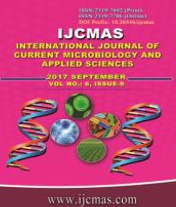


 National Academy of Agricultural Sciences (NAAS)
National Academy of Agricultural Sciences (NAAS)

|
PRINT ISSN : 2319-7692
Online ISSN : 2319-7706 Issues : 12 per year Publisher : Excellent Publishers Email : editorijcmas@gmail.com / submit@ijcmas.com Editor-in-chief: Dr.M.Prakash Index Copernicus ICV 2018: 95.39 NAAS RATING 2020: 5.38 |
A field experiment was conducted during 2015-16 and 2016-17 at Hyderabad to assess the performance of two cotton hybrids of which Bt (MRC 7201 BGII) and non-Bt cotton (WGCV-48) in response to plant densities (P1: 18,518 plants ha-1, P2: 55,555 plants ha-1 and P3: 1,48,148 plants ha-1) and nitrogen fertilization (120, 150 and 180 kg ha-1). During 2015 and 2016, MRC 7201 BG II cultivar recorded significantly more plant height (125.0 cm and 141.4 cm), LAI (5.23 and 4.95) and dry matter production (246 g plant-1 and 241 g plant -1), number of sympodial branches plant-1 (42, 40) and kapas yield (3497, 2866 kg ha-1) in comparison to WGCV-48 cultivar, respectively. Plant density P1 (18,518 plants ha-1) at 90 cm x 60 cm spacing recorded significantly more dry matter production (301g plant-1, 298 g plant-1) over P2 (55,555 plants ha-1) at 60 cm x 30 cm and P3 (1,48,148 plants ha-1) 45 cm x 15 cm spacing during 2015 and 2016 respectively. During 2015 and 2016, among the plant densities, even though the plant density of P1: 18,518 plants ha-1 showed more number of sympodial branches plant-1 (55, 53) and kapas yield plant-1 (149, 122), but the plant density of P2: 55,555 plants ha-1 significantly more kapas yield (3319, 2726 kg ha-1).
 |
 |
 |
 |
 |